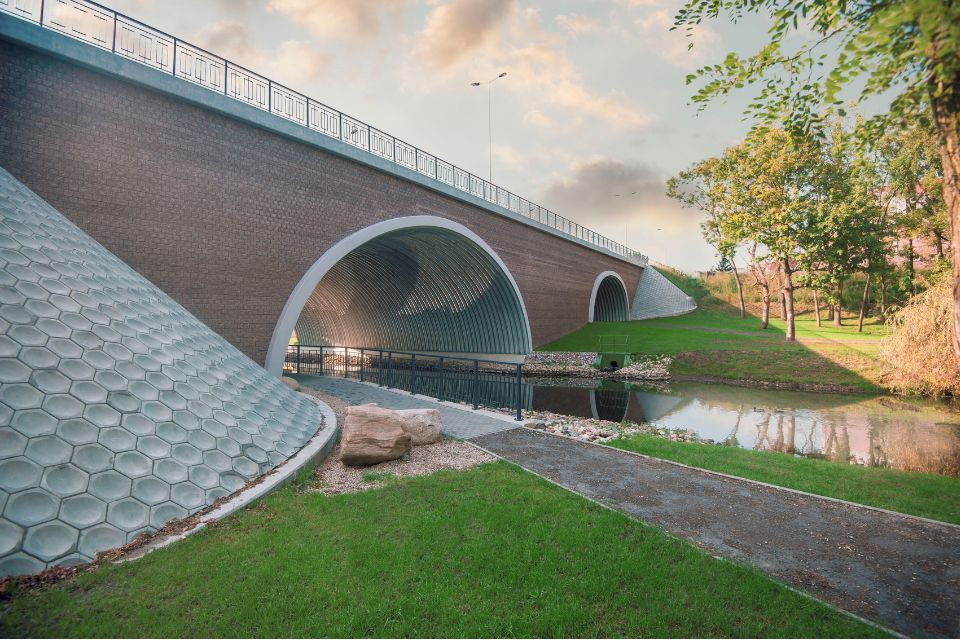What is the role of BREEAM in sustainable metal bridge construction?
BREEAM (Building Research Establishment Environmental Assessment Method) is a sustainability assessment framework for buildings and infrastructure. As sustainability becomes a central consideration in all aspects of construction, frameworks such as BREEAM are becoming increasingly important to create a globally recognized standard for specifying, measuring, and assessing the sustainability performance of construction projects and outcomes and their performance over time.
Launched in 1990, BREEAM has grown to become one of the most common building certifications in the industry globally, but especially within Europe. What does BREEAM measure? And how does its focus on sustainable value extend to infrastructure like metal bridges?
What does BREEAM measure?
BREEAM assessments, now seen as a benchmark for sustainable construction, measures a full construction project and its environmental impact – from the design and planning to procurement phases, which impact the construction of a project and its short and long-term operation and maintenance.
Based on the measurements taken and assessed, a construction project may then be rewarded for its social, economic or environmental credentials in a number of categories, including energy, land, and water use, pollution, transport, waste and materials management, and so on. Construction assessed under BREEAM may be awarded credits based on its predicted and actual performance in each category; the categories listed above govern some 47 individual assessment issues that BREEAM examines. Each issue addresses a specific construction-related environmental impact and has a specific number of ‘credits’ assigned to it.
The underlying mission is to achieve environmental aims and sustainable construction through measurable reductions in carbon emissions, lower-impact designs, biodiversity protections and other similar factors that influence how sustainable a project performs.
BREEAM certification and its sustainable value for metal bridge infrastructure
For metal bridge infrastructure, obtaining BREEAM certification carries benefits – both in terms of cost efficiency and total cost of ownership (TCO) improvements as well as longer-term sustainability, lifecycle performance and lifespan.
Cost efficiency and TCO
BREEAM-certified projects can ensure financial and economic benefits for construction projects. These may, for example, qualify for incentives or funding opportunities linked to green infrastructure. Additionally, sustainable metal bridges can lead to cost savings over time due to lower maintenance and operating costs and having a longer-lasting, more durable material profile, in particular using recyclable steel (and potentially reduced carbon footprint steel for an even lighter environmental footprint). BREEAM encourages the use of sustainable and recycled/recyclable materials like steel for bridges for these reasons.
Many modern metal fabrication techniques may use less energy in manufacture and require less energy or fossil fuels in transport, may require less construction time and have a lighter overall footprint to bring materials to the construction site. The modular nature of many steel bridge structures also cuts construction time and associated disruptions, creating time and disruption-related efficiencies. All of these factors can contribute to lower direct and indirect construction costs, reduced costs due to inconveniences like road closures and long construction periods, and a more sustainable rating for the project overall.
Sustainability, lifecycle performance and lifespan
Enhancing durability and lifecycle performance undergirds the overarching concept of sustainability. Steel bridges generally offer a longer lifespan than bridges built from competing materials, require less maintenance, and are built from an infinitely recyclable, durable material. This likewise promotes waste reduction and efficient use of resources.
BREEAM certification ensures that durability and sustainability are measurable by placing emphasis on lifecycle assessment (LCA) calculations, which project durability and cost-effectiveness figures over time throughout the infrastructure’s lifespan.
Soil-steel bridges, for example, also tend to have a much less significant ecological impact to the areas where they are built.
Innovation, regulation and perception
BREEAM certification has a number of other benefits as well, pertaining to innovation, regulatory compliance and public perception.
Innovation
Meeting BREEAM certification standards often leads to seeking out new and innovation solutions and techniques – such as more modular or advanced construction methods. This is true for metal bridges, which are made of lightweight corrugated steel structures instead of concrete. This enables a modular construction approach and cuts down energy, transport, and installation demands.
Regulatory compliance
While BREEAM itself is voluntary, complying with its principles aligns construction projects with many national and international sustainability policies and regulations – as well as schemes that allow for sustainable recognition and construction credits. This can make projects less expensive to build and can make future regulatory regimes easier to comply with while also potentially making a BREEAM-backed project proposal more attractive and competitive.
Public perception
BREEAM certification demonstrates a commitment to sustainability. While it’s no guarantee of enhancing public trust and reputation, it can be a boost to public perception, leading to community support, transparency and a smoother path to project approvals.
How can BREEAM principles be integrated into planning and building of sustainable metal bridges?
Designing and planning metal bridges with the BREEAM standards in mind from the start, engineers and architects are well-positioned for achieving high BREEAM ratings and reaping the benefits of demonstrably sustainable construction. As BREEAM becomes more important in infrastructure projects and across the civil engineering sector, cross-disciplinary collaboration between engineers, architects, project manager, and environmental consultants will make BREEAM-approved bridge construction the norm rather than the exception.
Ultimately this should not require a big change to how civil engineering projects are planned and implemented today – long-term planning is a big part of these large-scale projects. Incorporating considerations for BREEAM certification may add a few extra steps, but these would be required to demonstrate sustainability credentials anyhow.
How BREEAM certification matters for metal bridge construction
BREEAM certification matters for metal bridge infrastructure as it not only drives environmental stewardship but also ensures the structure’s efficiency, durability, and societal value. This can result in long-term benefits for both the environment and the communities relying on the infrastructure.

